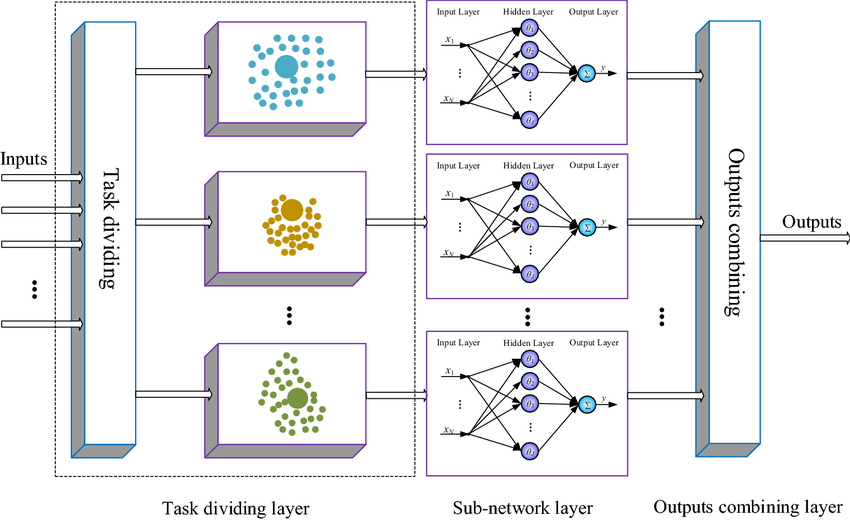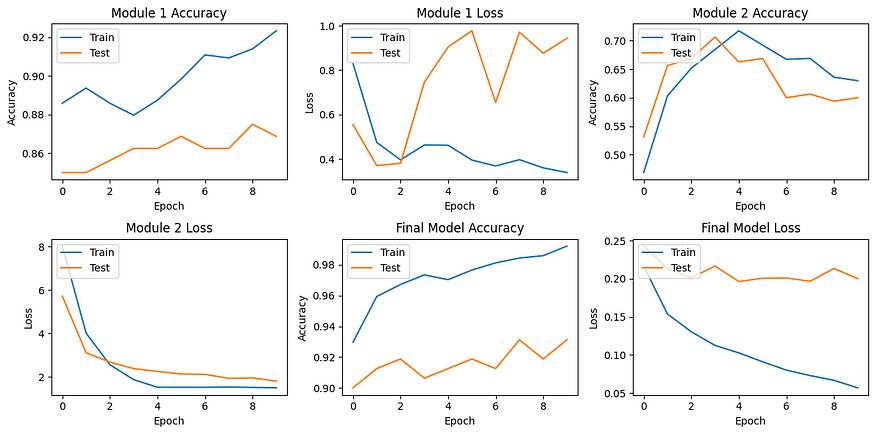一、介绍
在快速发展的人工智能领域,模块化神经网络 (MNN) 已成为一项关键创新。与遵循整体方法的传统神经网络架构不同,MNN 采用分散式结构。本文深入探讨了 MNN 的基础知识、它们的优势、应用以及它们带来的挑战。

在人工智能领域,模块化神经网络证明了协作智能的力量,体现了整体大于部分之和的原则。
二、了解模块化神经网络
模块化神经网络代表了神经网络设计的范式转变。核心思想是将复杂问题分解为更小的、可管理的子任务,每个子任务由专用模块处理。这些模块本质上是单独的神经网络,经过训练专门研究整个任务的特定方面。然后整合这些模块的输出以制定全面的解决方案。
在 MNN 中,每个模块都单独训练,从而实现专业化。这种分散式训练方法与传统网络形成鲜明对比,在传统网络中,单一模型针对任务的各个方面进行训练。训练后,这些模块通过分层结构或网络进行协作,其中某些模块的输出可作为其他模块的输入。
2.1 模块化神经网络的优点
- 专业化和效率:MNN 的划分性质允许专业化,从而提高解决复杂任务的效率和有效性。每个模块都成为其特定领域的专家,使网络擅长处理多方面的问题。
- 可扩展性和灵活性:MNN 提供卓越的可扩展性和灵活性。可以添加新模块或更新现有模块,而无需重新训练整个网络。这种模块化架构使得 MNN 特别适合不断变化的任务和环境。
- 并行处理和速度:分散的结构有利于并行处理,显着加快计算速度。由于模块可以独立运行,MNN 非常适合分布式计算环境。
2.2 模块化神经网络的应用
- 机器人和自主系统:在机器人技术中,MNN 可以控制机器人的不同部分或功能。例如,单独的模块可以处理感官处理、运动协调和决策,从而形成更高效、适应性更强的机器人系统。
- 复杂问题解决:MNN 擅长解决可以分解为更小部分的复杂问题。这包括自然语言处理等领域,其中不同的模块可以处理语法、语义和上下文。
- 个性化和自适应系统:在推荐系统和个性化内容交付中,MNN 可以通过调整特定模块来适应个人用户的偏好和行为,而无需彻底检修整个系统。
2.3 挑战和未来方向
- 集成和协调: MNN 的主要挑战之一是模块的集成和协调。确保模块之间的无缝通信和协作对于网络的有效性至关重要。
- 设计和维护的复杂性:MNN 的设计和维护可能很复杂。确定模块的最佳数量、它们的具体角色和整体架构需要仔细的规划和专业知识。
- 未来展望: MNN 的未来研究可能会集中在自动化模块集成、模块间通信的高级训练算法以及探索更多样化领域的应用。
三、代码
使用 Python 创建模块化神经网络 (MNN) 的完整代码示例涉及几个步骤:生成合成数据集、为网络设计单独的模块、训练这些模块,最后集成它们。出于演示目的,我将创建一个简化的 MNN,使用合成数据集解决分类问题。我们将使用诸如numpy数据操作以及tensorflow构建和训练神经网络之类的库。
确保您安装了 TensorFlow 和其他必需的库。您可以使用 pip 安装它们:
pip install numpy tensorflow matplotlib sklearn让我们开始编写 Python 代码:
import numpy as np
import tensorflow as tf
from sklearn.datasets import make_classification
from sklearn.model_selection import train_test_split
from sklearn.metrics import accuracy_score
import matplotlib.pyplot as plt# Step 2: Generate Synthetic Dataset
X, y = make_classification(n_samples=1000, n_features=20, n_informative=15, n_redundant=5, random_state=42)
X_train, X_test, y_train, y_test = train_test_split(X, y, test_size=0.2, random_state=42)# Split features for two modules
X_train_mod1 = X_train[:, :10]
X_train_mod2 = X_train[:, 10:]
X_test_mod1 = X_test[:, :10]
X_test_mod2 = X_test[:, 10:]# Step 3: Designing Modular Neural Networks
def create_module(input_shape):model = tf.keras.models.Sequential([tf.keras.layers.Dense(64, activation='relu', input_shape=input_shape),tf.keras.layers.Dense(32, activation='relu'),tf.keras.layers.Dense(16, activation='relu')])return modelmodule1 = create_module((10,))
module2 = create_module((10,))# Step 4: Training the Modules
module1.compile(optimizer='adam', loss='sparse_categorical_crossentropy', metrics=['accuracy'])
module2.compile(optimizer='adam', loss='sparse_categorical_crossentropy', metrics=['accuracy'])module1.fit(X_train_mod1, y_train, epochs=10, batch_size=32, verbose=0)
module2.fit(X_train_mod2, y_train, epochs=10, batch_size=32, verbose=0)# Step 5: Integration and Final Classification
combined_input = tf.keras.layers.concatenate([module1.output, module2.output])
final_output = tf.keras.layers.Dense(2, activation='softmax')(combined_input)
final_model = tf.keras.models.Model(inputs=[module1.input, module2.input], outputs=final_output)final_model.compile(optimizer='adam', loss='sparse_categorical_crossentropy', metrics=['accuracy'])
final_model.fit([X_train_mod1, X_train_mod2], y_train, epochs=10, batch_size=32, verbose=0)# Evaluation
y_pred = np.argmax(final_model.predict([X_test_mod1, X_test_mod2]), axis=1)
accuracy = accuracy_score(y_test, y_pred)
print(f'Accuracy: {accuracy}')# Step 6: Plotting the Results
# Here you can add any specific plots you want, like loss curves or accuracy over epochs.
import matplotlib.pyplot as plt# Modifying the training process to store history
history1 = module1.fit(X_train_mod1, y_train, epochs=10, batch_size=32, verbose=0, validation_split=0.2)
history2 = module2.fit(X_train_mod2, y_train, epochs=10, batch_size=32, verbose=0, validation_split=0.2)
final_history = final_model.fit([X_train_mod1, X_train_mod2], y_train, epochs=10, batch_size=32, verbose=0, validation_split=0.2)# Plotting
plt.figure(figsize=(12, 6))# Plot training & validation accuracy values for Module 1
plt.subplot(2, 3, 1)
plt.plot(history1.history['accuracy'])
plt.plot(history1.history['val_accuracy'])
plt.title('Module 1 Accuracy')
plt.ylabel('Accuracy')
plt.xlabel('Epoch')
plt.legend(['Train', 'Test'], loc='upper left')# Plot training & validation loss values for Module 1
plt.subplot(2, 3, 2)
plt.plot(history1.history['loss'])
plt.plot(history1.history['val_loss'])
plt.title('Module 1 Loss')
plt.ylabel('Loss')
plt.xlabel('Epoch')
plt.legend(['Train', 'Test'], loc='upper left')# Plot training & validation accuracy values for Module 2
plt.subplot(2, 3, 3)
plt.plot(history2.history['accuracy'])
plt.plot(history2.history['val_accuracy'])
plt.title('Module 2 Accuracy')
plt.ylabel('Accuracy')
plt.xlabel('Epoch')
plt.legend(['Train', 'Test'], loc='upper left')# Plot training & validation loss values for Module 2
plt.subplot(2, 3, 4)
plt.plot(history2.history['loss'])
plt.plot(history2.history['val_loss'])
plt.title('Module 2 Loss')
plt.ylabel('Loss')
plt.xlabel('Epoch')
plt.legend(['Train', 'Test'], loc='upper left')# Plot training & validation accuracy values for Final Model
plt.subplot(2, 3, 5)
plt.plot(final_history.history['accuracy'])
plt.plot(final_history.history['val_accuracy'])
plt.title('Final Model Accuracy')
plt.ylabel('Accuracy')
plt.xlabel('Epoch')
plt.legend(['Train', 'Test'], loc='upper left')# Plot training & validation loss values for Final Model
plt.subplot(2, 3, 6)
plt.plot(final_history.history['loss'])
plt.plot(final_history.history['val_loss'])
plt.title('Final Model Loss')
plt.ylabel('Loss')
plt.xlabel('Epoch')
plt.legend(['Train', 'Test'], loc='upper left')plt.tight_layout()
plt.show()
该脚本演示了模块化神经网络的基本实现。根据您的具体问题,架构、模块数量及其集成方式可能会有很大差异。另外,请记住根据任务的复杂性调整纪元、批量大小和网络层。
四、结论
模块化神经网络标志着人工智能领域的重大进步,提供了灵活、高效且可扩展的问题解决方法。它们处理复杂、多方面任务的能力使它们成为各种应用中的宝贵工具。虽然它们带来了一定的挑战,但正在进行的研究和开发有望进一步增强它们的能力,巩固它们在人工智能未来的作用。
![MySQL5.7无法连接到[本地] MySQL 服务器](http://pic.xiahunao.cn/MySQL5.7无法连接到[本地] MySQL 服务器)
)


)








)




的实现)
